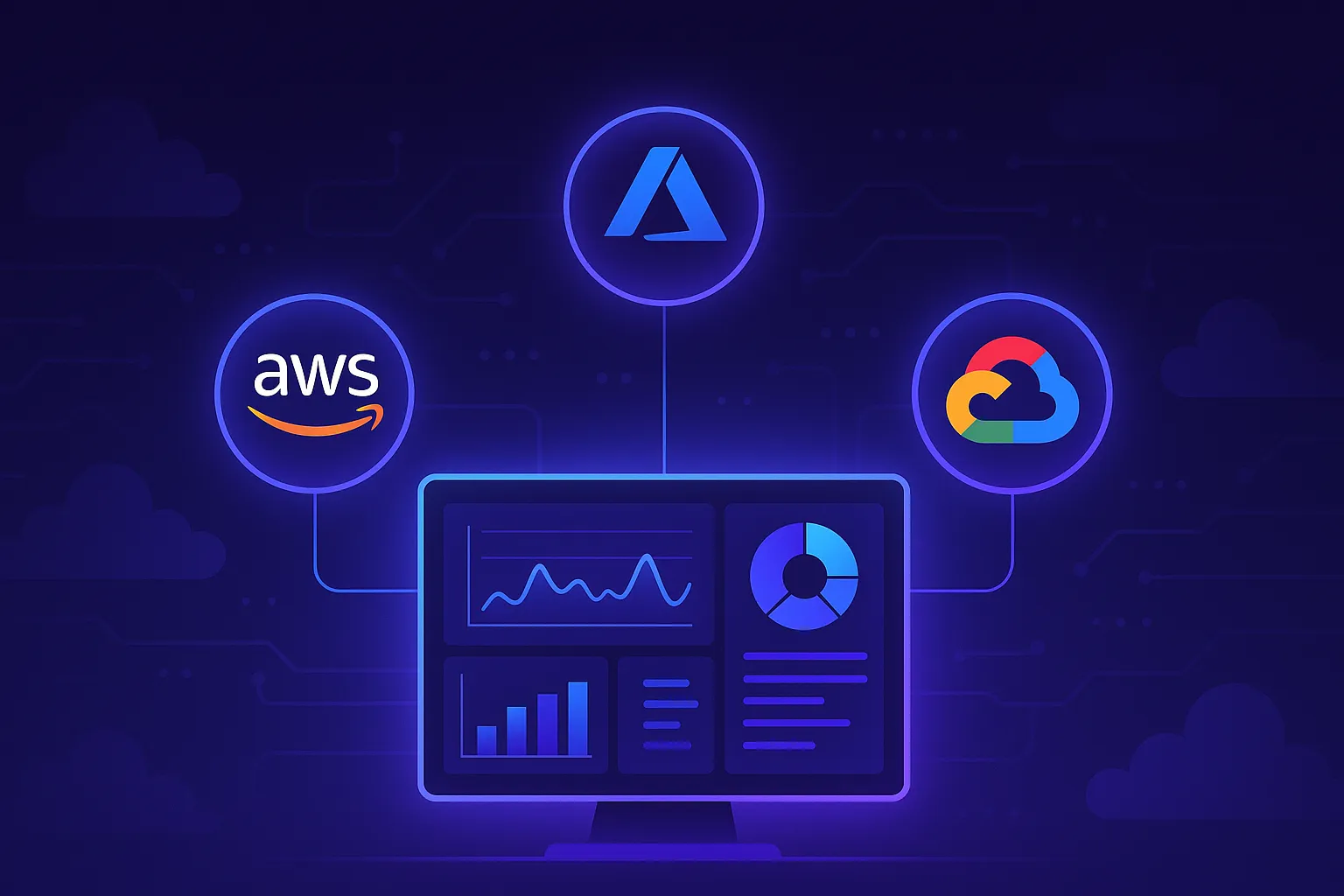Managing multiple cloud platforms might boost flexibility, but it often buries IT teams in complexity. Each environment comes with its tools, dashboards, and alerts, leaving operations fragmented and visibility limited. When critical issues arise, the lack of a unified view means slower detection, delayed response, and rising costs.
That is why unified monitoring in multi-cloud environments is no longer optional, it is foundational. By bringing observability under a single pane, and enhancing it with AIOps-driven intelligence like Parkar’s Vector, businesses can finally shift from reactive monitoring to proactive control.
The Pitfalls of Fragmented Monitoring in Multi-Cloud Setups
When enterprises operate across AWS, Azure, Google Cloud, and private infrastructure, monitoring often becomes a maze. Each provider offers distinct monitoring capabilities, but they don’t talk to each other. This disjointed setup introduces three core challenges:
- Blind Spots in Performance and Availability
Without a unified view, teams struggle to correlate events across platforms. An application slowdown might stem from a storage issue in one cloud and a network bottleneck in another, but these connections are easily missed. - Slow Incident Response
Multiple dashboards mean fragmented alerts. IT teams waste precious time switching between tools, deciphering inconsistent metrics, and manually stitching logs together to understand root causes. - Higher Operational Overhead
Maintaining and training teams on different tools not only stretches resources but also increases the risk of human error. The result is inefficiency at scale and precisely what cloud adoption was supposed to eliminate.
Fragmentation does not just affect performance, it undermines the promise of agility that multi-cloud strategies aim to deliver.
The Imperative for Unified Monitoring
In a landscape where speed and reliability define success, unified monitoring in multi-cloud environments is the key to reclaiming control. It eliminates guesswork by consolidating all metrics, logs, and traces, regardless of cloud provider, into one intelligent view.
With a centralized dashboard, IT teams can:
- Visualize everything in real time: One screen shows everything from compute to storage to application performance to cutting down noise and confusion.
- Correlate issues faster: AIOps engines, like those behind Parkar’s Vector, use pattern recognition to identify anomalies across environments, helping teams resolve incidents before they escalate.
- Standardize alerting and response: No more juggling tool-specific rules or inconsistent thresholds. Unified policies ensure consistent monitoring across clouds.
Beyond just visibility, unified monitoring brings predictive intelligence and automated remediation, laying the groundwork for more resilient and self-healing systems.
Strategies for Implementing Centralized Monitoring
Shifting from fragmented visibility to a unified monitoring approach requires more than just tool adoption, it demands a deliberate architectural and operational shift. Here are key strategies that can guide enterprises in building a future-ready monitoring framework:
- Deploy a Centralized, Platform-Agnostic Monitoring Layer
Start by integrating a monitoring solution that supports diverse cloud ecosystems such as AWS, Azure, GCP, private cloud under a single pane of glass. This allows teams to visualize application and infrastructure metrics consistently, regardless of provider. - Embed AIOps Intelligence into the Monitoring Core
AIOps platforms bring the critical layer of intelligence needed to handle multi-cloud complexity. They analyze massive volumes of telemetry data, detect anomalies in real time, and surface meaningful patterns automating root cause analysis and reducing alert fatigue. - Unify Telemetry Collection Across the Stack
Standardize collection of logs, metrics, traces, and events from all environments and feed them into a centralized observability pipeline. This holistic data stream forms the foundation for actionable insights and AI-driven decision-making. - Automate Alerting and Incident Remediation
Leverage AI models to auto-prioritize alerts based on impact, historical trends, and context. Coupled with policy-based automation, teams can define rules for remediation, like auto-scaling, service restarts, or traffic rerouting, without manual intervention. - Align Monitoring with Governance and Compliance
Ensure that centralized monitoring frameworks respect organizational policies by enforcing RBAC, encrypting data in transit and at rest, and maintaining audit trails. This is especially critical for regulated sectors like healthcare and finance.
By combining unified dashboards with AIOps capabilities, organizations move from merely watching systems to intelligently managing them, turning their monitoring setup into a true enabler of resilience and agility.
Case Study: Financial Sector's Transition to Unified Monitoring
Form3, a UK-based fintech specializes in payment processing, came under more regulatory investigation for its dependence on one cloud provider. Regulators asked important questions: Should the leading cloud provider go down, what then? Does the platform go across several cloud environments?
Form3 used a multi-cloud approach, spreading its services over AWS, Azure, and Google Cloud to allay these worries. This strategy improved the platform's compliance posture and robustness and reduced the risks connected to vendor lock-in. Form3 guaranteed consistent data replication and high availability across all cloud settings by using a
distributed SQL database, CockroachDB.
A single monitoring system was required to keep visibility and control over the distributed systems within a multi-cloud architecture. Centralized dashboards and observability technologies let Form3 track performance indicators, find abnormalities, and quickly react to events regardless of the underlying cloud architecture.
Apart from fulfilling legal standards, this strategic action positioned Form3 to provide continuous services to its worldwide customers, hence proving the vital importance of unified monitoring in multi-cloud settings.
Overcoming Challenges in Unified Monitoring Implementation
Implementing unified monitoring in a multi-cloud setup sounds ideal, but the path to consolidation has its friction points.
One major challenge is integrating disparate telemetry sources across cloud providers. Each uses different metric formats and APIs, making consistency difficult to establish. Overcoming this requires platform-agnostic tools that can normalize data for unified analysis.
Another concern is managing alert volume. Without intelligent filtering, teams face alert fatigue. Here, AIOps-powered platforms like Vector help by contextualizing data and suppressing noise, ensuring only actionable insights surface.
Finally, centralizing monitoring raises compliance and governance questions. To mitigate risk, organizations must ensure secure data handling with role-based access, encryption, and audit trails baked into their monitoring stack.
Conclusion: Embracing Unified Monitoring for Future-Ready Operations
As companies expand across clouds, managing performance, availability, and risk becomes more complex. While relying on fragmented tools may have been effective in the early cloud age, it now creates more problems than it solves.
Unified monitoring in multi-cloud settings is about resilience, agility, and smart decision-making rather than only about visibility. Platforms like Vector allow companies to identify problems more quickly, automate reactions, and keep a consistent experience across all services by centralizing observability and combining AIOps features.
The future of IT operations involves not adding additional tools but simplifying and streamlining the ones that count.
Ready to change from reactive to proactive operations? Contact Parkar's excellent team to reach your business goals.
FAQ’s
1. Why is unified monitoring critical for multi-cloud environments?
Unified monitoring eliminates visibility gaps caused by using separate tools across cloud providers. It enables centralized control, faster incident response, and consistent performance insights, ensuring operational efficiency as organizations scale.
2. How does AIOps improve unified monitoring?
By using machine learning on massive amounts of observability data, AIOps improves unified monitoring. Platforms like Vector.ai employ it to identify anomalies, forecast failures, and automate reactions, hence lowering noise and allowing proactive operations.
3. What should enterprises consider when implementing unified monitoring?
Key considerations include tool interoperability across cloud platforms, data security, regulatory compliance, and the ability to scale. Choosing a platform that supports AI-driven insights and offers a seamless integration layer is crucial for long-term success.
















